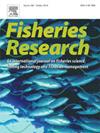从船只运动数据中识别捕捞行为组:在德国褐虾船队中的应用
IF 2.2
2区 农林科学
Q2 FISHERIES
引用次数: 0
摘要
北海的德国褐虾(Crangon Crangon)船队因油价上涨和虾价难以预测而减少。此外,该渔业正在调整其区域使用,以适应新的欧盟自然2000条例。我们分析了十三年的船舶监测系统(VMS)数据的空间和时间,以调查渔民的行为,这一特定的限期。来自211艘渔船的1938408个VMS ping被分为四个行为组,这些行为组在渔船长度、发动机功率、褐虾总捕获量和单位努力着落量(LPUE)方面存在差异。我们评估了最近实施的和未来与欧盟2023行动计划相关的海洋保护区(MPA)关闭的潜在影响。前者与捕虾者捕捞的区域重叠可以忽略不计,但后者覆盖了2009-2021年期间70% %的褐虾捕捞源。受影响最大的行为组包括119艘船,其特点是尺寸较小(船长~ 16 m),在没有努力重新安置或行为适应的情况下,潜在的着陆减少了高达80% %。我们的研究结果表明,针对同一物种的船只在捕捞行为和空间足迹方面存在差异。更一般地说,我们的方法评估了捕捞行为的多样性,并强调了对不断变化的经济和管理条件的不同适应性。本文章由计算机程序翻译,如有差异,请以英文原文为准。
Identifying fishing behavior groups from vessel movement data: Application to the German brown shrimp fleet
The German brown shrimp (Crangon crangon) fleet in the North Sea is declining due to rising fuel costs and unpredictable shrimp prices. Furthermore, this fishery is adapting their area use to new EU Natura 2000 regulations. We analyze thirteen years of Vessel Monitoring System (VMS) data spatially and temporally to investigate fisher behavior for this specific métier. A total of 1938408 VMS pings from 211 vessels are clustered into four behavioral groups differing in vessel length, engine power, total brown shrimp catch, and landing per unit effort (LPUE). We evaluated the potential effect of recently implemented and future marine protected area (MPA) closures linked to the EU Action Plan 2023. The former have negligible overlap with areas exploited by shrimp fishers, but the latter cover grounds from which 70 % of brown shrimp landings originated during 2009–2021. The most affected behavioral group includes 119 vessels, characterized by smaller sizes (vessel length ∼ 16 m), with potential landings decreasing by up to 80 % without effort relocation or behavioral adaptation. Our results show that vessels targeting the same species differ in fishing behavior and spatial footprints. More generally, our approach assesses diversity in fishing behavior and highlights varying adaptability to changing economic and management conditions.
求助全文
通过发布文献求助,成功后即可免费获取论文全文。
去求助
来源期刊

Fisheries Research
农林科学-渔业
CiteScore
4.50
自引率
16.70%
发文量
294
审稿时长
15 weeks
期刊介绍:
This journal provides an international forum for the publication of papers in the areas of fisheries science, fishing technology, fisheries management and relevant socio-economics. The scope covers fisheries in salt, brackish and freshwater systems, and all aspects of associated ecology, environmental aspects of fisheries, and economics. Both theoretical and practical papers are acceptable, including laboratory and field experimental studies relevant to fisheries. Papers on the conservation of exploitable living resources are welcome. Review and Viewpoint articles are also published. As the specified areas inevitably impinge on and interrelate with each other, the approach of the journal is multidisciplinary, and authors are encouraged to emphasise the relevance of their own work to that of other disciplines. The journal is intended for fisheries scientists, biological oceanographers, gear technologists, economists, managers, administrators, policy makers and legislators.
 求助内容:
求助内容: 应助结果提醒方式:
应助结果提醒方式:


